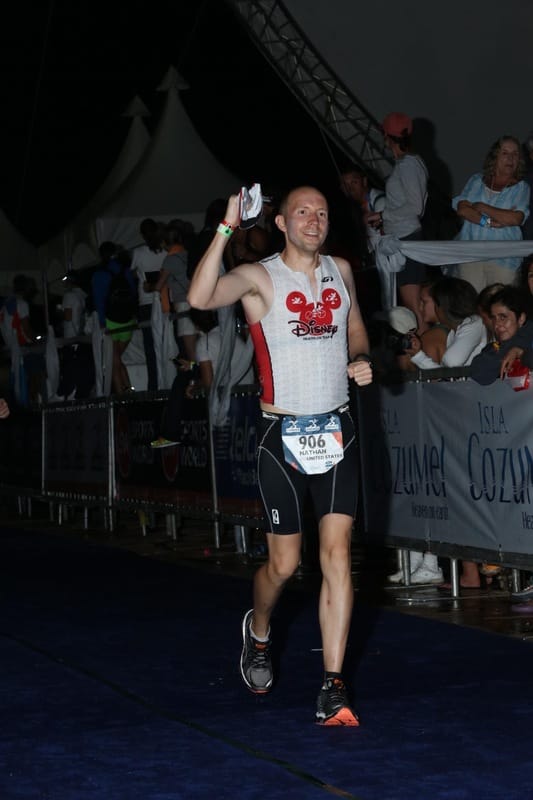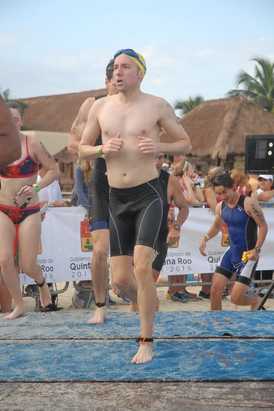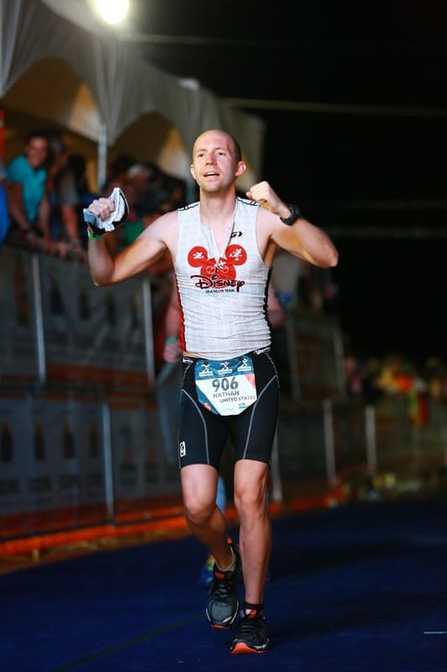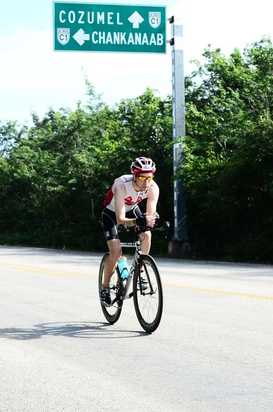|
I arrived on the island of Cozumel Wednesday night, the day before Thanksgiving, four days before the race. The days leading up to the race were spent working out - short workouts to acclimate to the climate and keep the legs engaged – attending pre-race meetings, obsessively taking an inventory of my gear, and waiting. There was concern up to the day before the race that the swim portion would be canceled due to dangerous ocean currents. The swim course started from the Chankanaab pier and headed north making a rectangular path before returning to the pier from the south. The concern was for athlete safety, but also the possibility that many athletes, having to swim against the current for a significant portion of the course, would not make it out of the water by the swim cut-off time thus ending their day before they touched their bike. The race officials announced the evening before the race that the swim course would be moved and become a point-to-point course, starting 2 miles north of the pier and heading south along the coast. I was relieved to hear that the swim would commence. I didn’t come to bike and run. I came to swim, bike, and run. The night before the race I felt like there was a Tesla coil of nervous energy in the pit of my stomach firing an anxious bolts at irregular intervals. Though I knew it was important to get some sleep, there was not much sleep to be had. My mind flickered with a kaleidoscope of questions. Something will go wrong, what will it be? Was I prepared? Did I train enough? Would my day end in agony with me crawling across the finish line? I closed my eyes and drifted off to some quasi-slumber, waking every hour to check the time. The alarm went off at 4 am. I didn’t need it. I was up and ready to go. I arrived at the race start, dropped off my gear, and pumped the tires on my bike. Music played through transition area, but it wasn’t the typical “get pumped up” pop songs that you hear at most races. Those beats were saved for the finish line. At the starting line, dramatic movie scores filled the air while the orange sun rose above the blue horizon. The voice of Ironman greeted the athletes over the loudspeaker, giving instructions and countdown to the start. The tone, intentionally set from the beginning, was that this day was going to be epic. With my swim cap and goggles in hand and wearing only my tri-shorts I climbed into the bus that would take me to the swim start. I’ve never been packed so tightly on a bus with so many strangers wearing so little clothing. The cannon went off at 7:00 am for the pro athletes. Then the rest of the field, approximately 2,000 “age-groupers,” took our place in the water. The announcement came: one minute. The anticipation hit a fever pitch, and a roar erupted from the athletes in the water. I think it was one part exuberance, one part nervousness, and one part holy s***. At 7:10 am the cannon went boom. The swim is the first of the three disciplines. In some ways it’s the easiest; it is the start of the race, and if your training went well you’re at peak fitness and the most rested you’ll be the entire day. But the swim brings its unique set of challenges. Cozumel was an open water ocean swim. Unlike swimming in a pool you have the variables of currents and waves, ocean life swimming next to you, and the task of sighting to stay on course. Most difficult though is the mass start, 2,000 other swimmers with their 4,000 arms and 4,000 feet flailing and kicking next to you in the water. It’s a swarm of humanity, and it’s chaos. I knew I would get kicked and pushed and swam over if I wasn’t careful. For the most part, it's not malicious, but when you take a foot to the face it tends to put a person in an off mood. The key was to protect myself, guard my head, and stay calm. Eventually, the field spread out and though I was never without company, space opened and I was able to settle into a steady stroke. The water in Cozumel is pristine and warm. It’s quite beautiful. During the entire swim I could see to the ocean floor. Watching schools of fish weave through the coral made for a good distraction while I glided through the water as best I could. I can thank the shortened swim course for my arrival at the first transition about 15 minutes sooner than planned. I pulled myself out of the water and except for a couple of minor jellyfish stings I was in one piece. I ran like a drunken man to the transition tent (when you suddenly go vertical after swimming horizontally in choppy water for an hour, your sense of balance is a little off). I entered the transition tent, put on my cycling gear, and lathered up on sunblock. Nine minutes later I was exiting the transition area on my bike. The bike course consisted of three loops around the island. It was flat as a pancake and the 12 mile stretch along the east side of the island was right along the coast which offered dramatic views of crashing waves and the expansive blue sea. It all sounds good on paper, but in reality, the course exposed every weakness I had on the bike. I don’t have big powerful legs that can push and pull a high wattage over long periods of time. My lean frame is better suited for climbing not grinding. It would be a long day on the bike. I’d been warned about the crosswinds on the east side of the island, but on this day the winds had shifted and became a brutal headwind. The wall of moving air hit when the road turned north, its invisible force pushing against me for a stretch of about 10 miles. On the first loop, the sustained winds were about 20 mph, by the third loop, after the air had warmed, the sustained winds were touching 30 mph. There was nothing I could do about the wind except put my head down and pedal through it. I did math in my head to keep my mind distracted. The wind was only one of the challenges faced on the bike. An early rain gave way to a hot and humid sun. The sunblock I applied in transition was washed away, I realized about halfway through the bike that my skin was burning. I stopped at an aid station and asked for sunscreen. The teen volunteer applied the pasty lotion to my shoulders and neck and face. I looked like a character from the movie Apocalypto, but least I was protected. Around mile 70 I reached the special needs station where I stopped for my bag. In an Ironman race every athlete has the option to leave a “special needs” bag on the course, which is available to them on the bike and the run. Stopping at the special needs station was part of my race plan. In my special needs bag, I had a spare tube for my bike, a second bottle of nutrition, and a Snickers and Payday. The candy bars were more for my mental health than my physical wellbeing. The Snickers was completely melted and inedible. The Payday, however… let’s just say I’ve never tasted salty caramel goodness so glorious in all my life. I was back on my bike with my spirits boosted when I took a sip from my bottle and I knew immediately that something was wrong. My bottle, which I had measured out the exact number of calories I would need, was spoiled. It was later that I would realize the nutrition I used had a small amount of dairy (protein) in the mix and the heat and humidity turned the mixed sour. I still had 40 miles on the bike and marathon to run; I had to figure something out. There was nutrition on the course, but I had never trained with the brands of food and energy drinks they provided. I didn’t know what was in it or what how much I would need. I was mid-day the sun was high, and it was getting hot. I had no choice but to take what was available to me. I kept thinking, as your stomach goes, so goes your race. I was praying that my body would accept the food. Fortunately, it did. With each loop around the island we passed through the heart of Cozumel. Locals were alongside the road for hours cheering us on. The children built makeshift noisemakers using plastic bottles and rocks. I couldn’t help but think the bicycles many of us athletes were riding probably cost more than their families make in several months time. I was so grateful for the local support. I needed it. On the first loop, I was all smiles and thumbs-up. The second time around a nod of the head and a slight wave was all I could muster. The third time around my legs were screaming. My skin was burnt. My hands were numb. My shoulders ached. My butt, well… I think you can image how that felt. I had been on my bike for nearly 7 hours. It was 30-45 minutes longer than I anticipated. I was at the mercy of the wind and the wind won the day. But as I have learned, if you keep going, you will eventually arrive. And arrive I did. The bike finish was a beautiful site to behold. I handed my bike to a volunteer and entered the transition tent. I was never so thrilled to running a marathon in my life because it meant I was done with the bike. The run start and finish were at the center of town where the mass of spectators was gathered. The roar of the crowd, the steady clank of cowbells, and the fact that two of the three events were now behind me led to a burst of inspiration and renewed strength. It was hard not to get caught up in the moment. It was thrilling. But the moment would not last. The first downpour came around mile three and with it the crowds of supporters retreated from the streets for the dry cover of restaurants and shops. The rain turned out to be a blessing and a curse. The blessing was that it brought relief from the heat of the day. The curse was that I would run the next 23 miles soaking wet from my head to my feet. It was just after the first rain that my angel came along side me. I call him my angel because I have no idea who he was. He was older than me, maybe in his 50s. We didn’t talk to each other, and the only words I heard from him were in Spanish. We paced each other running shoulder to shoulder for miles. Early, when the heat was still an issue, he grabbed a wet sponge and handed it to me. A kind gesture that saved me the hustle of finding relief for myself. As the miles passed I felt gratitude and loyalty to this man. His presence encouraged me. I was determined not let him down. I would do my part hold the pace. The run course consisted of 3 out-and-back loops, which on the one hand was repetitive and somewhat boring, but on the other hand it allowed me to see the other athletes on the course. It gave me a chance to check-in with my friends and get a quick update on how their race was going. It was on the second loop heading away from the city that I passed through an aid station. When I looked back, my angel was gone. I slowed a bit and looked around, but he was nowhere to be found. Our unspoken but understood agreement was that we would pace each other and help each other, but we would not wait for the other. I kept going. The run was my strongest of the three disciplines. For the first 13 miles I maintained a steady pace. But as the miles wore on, as the sun set and the darkness rose, my body grew weak and my mental strength began to crack. Around mile 15, I had a most delightful surprise. My angel returned. I looked to my left and there he was. I smiled and nodded. He nodded back to me and we forged ahead together once again. His timing was good. I needed his help. My legs were crumbling beneath me. His steady pace pulled me along. We trotted back to the city and I made my turn to begin my third and final lap. My angel did not follow me. He continued into the finishing chute. It turns out my angel was pretty fast. He was a full lap ahead of me. His race was nearly complete. We bid each other good luck and went our separate ways. Turning my back on the finish and heading out of town for my final lap was the hardest thing I would do that day. I wanted to be done. Mentally, physically, emotionally I was finished. But the race was not 131 miles it is 140 miles and I still had nine miles to go. Storytellers have a phrase for the moment in a narrative when all hope is lost, when the hero enters the darkest cave and experiences the lowest of lows. The moment is called “the dark night of the soul” and I had just entered it. Pain is not the word to describe what I was experiencing. Yes, I was in pain, but it was more than that. Broken is a better word. An iron blanket of weariness wrapped my being and grew heavier and heavier. My feet were swollen and hips were screaming. Every stride sent an ache-filled throb through my legs. Every step was accompanied with a mental plea to stop. I had to make a deal with myself; when I reached an aid station, which was about every mile, I would allow myself to walk from the first table to the last table then I must start running again. I kept my deal. I walked through the aid station sipping on some Gatorade or Pepsi. At the last table I tossed the cup and started running again. One foot in front of the other, that is how I covered miles 17-23. There was a bend in the road at mile 24. The lights of the city came into view and a wave of pulsing music echoed from the finish line. There was literally a light at the end of my dark night of the soul. I pressed forward without stopping. With each step I came closer and closer to my destination. A final burst of energy rose from some reserve hidden deep in my bones. Spectators, awaiting their loved one’s arrival, lined the streets. They promised me the finish was just a bit further and that “I could do it.” Soon I could hear the voice of Ironman calling the names of finishers. I entered the final chute. A blue carpet laid the path. There was a sharp 90-degree turn to the left and then I saw it: the finish line a hundred yards ahead of me. I rushed forward. The lights were bright. Heaven opened and I heard the voice of God say, “Nathan Davis, you are an Ironman.” For the record, this will be the only time I post a picture of me with my shirt off on this website. :)
0 Comments
Leave a Reply. |
AuthorA WRITER AND TRAVELER KEEPING THE FAITH IN LOS ANGELES Subjects
All
Archives
August 2022
© 2022
|




 RSS Feed
RSS Feed